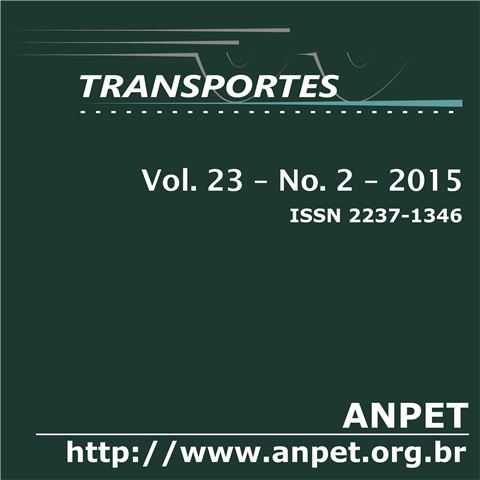.
DOI:
https://doi.org/10.14295/transportes.v23i2.746Keywords:
high-speed railway, linear civil work, contaminated areas, environmental management, conceptual model of the contamination, environmental impact, health risk.Abstract
The objective of this study is to propose a methodology to the environmental management of linear civil works (such as high-speed railways) in sections where the route intersects contaminated, potentially contaminated or suspected contaminated areas. The case study used the proposed method for the Preliminary Environmental Site Assessment for the future deployment of high-speed train between Rio de Janeiro and Campinas (TAV). The method consists in performing the following work steps: (a) to identify and characterize contaminated, potentially contaminated and suspected contaminated sites; (b) to classify the sections of the route, c) to elaborate the conceptual models of contamination; (d) to identify the scenarios and the environmental implications to the civil works and e) to propose environmental management actions. The environmental management actions proposed by the study had as objectives to minimize the environmental impacts and to guarantee the health safety to the construction workers when considering contaminated sites. Additionally, the proposed strategy should help to prevent any delays in issuing environmental permits and increased development costs.Downloads
References
ABNT (2013) ABNT – Associação Brasileira de Normas Técnicas (2013). NBR 16210 – Modelo conceitual no gerenciamento de áreas contaminadas - Procedimento. Rio de Janeiro.
ANTT (2012). Agência Nacional de Transportes Terrestres. Trem de alta velocidade - TAV Brasil. Disponível em www.antt.gov.br/index.php/content/view/5448/Trem_de_Alta_Velocidade___TAV.html, acessado em 14. Dezembro, 2012.
Assembléia Legislativa do Estado de São Paulo. Lei Estadual nº 13.577, de 8 de julho de 2009. Dispõe sobre diretrizes e proce-dimentos para a proteção da qualidade do solo e gerenciamento de áreas contaminadas. São Paulo.
CETESB (2001). Companhia de Tecnologia de Saneamento Ambiental. Manual de Gerenciamento de Áreas Contaminadas.
CETESB (2007). Companhia Ambiental do Estado de São Paulo. Decisão de Diretoria N° 167/2007. Dispõe sobre procedimentos para gerenciamento de áreas contaminadas. São Paulo.
CONAMA – Conselho Nacional de Meio Ambiente (2009) – Resolução nº 420 de 28 de Dezembro de 2009. Dispõe sobre critérios e valores orientadores de qualidade do solo quanto à presença de substâncias químicas e estabelece diretrizes para o gerenciamento ambiental de áreas contaminadas por essas substâncias em decorrência de atividades antrópicas. Brasília.
Lieggio Jr, M.; Filho, J. K. D. M.; Alves C. F. C.; Barbosa, A. O.; Cagnon, F. A. (2012). Implantação de ferrovias de alta velocidade e meio ambiente: Identificação e caracterização de áreas contaminadas. Revista ANTT, v. 4, n. 1, 90-110.
Mattiaso, D.P (2010). Nova Fase para Gestão de Solos Contaminados. Revista Meio Ambiente Subterrâneo, São Paulo, Ano 3, n. 14, p. 18-19.
PRIME (2008). Prime Engenharia. Estudos Ambientais de Alter-nativas para o Trem de Alta Velocidade (TAV) - Relatório Preli-minar. Inter - American Development Bank / Prime Engenharia: São Paulo - SP.
REGEA (2012). Geologia e Estudos Ambientais. Caracterização de Áreas Potencialmente Contaminadas - Fase 1. REGEA, São Paulo - SP.
Sánchez, L. E. (1998). A desativação de empreendimentos industriais: um estudo sobre o passivo ambiental. 178 f. Tese (Livre-Docência) - Escola Politécnica, Universidade de São Paulo, São Paulo.
Santos, A. P. R. (2012) Diretrizes para minimização de interferências de áreas contaminadas nos cronogramas dos empreendimentos do metrô de São Paulo, Brasil. São Paulo, 2012. 99p.
USEPA (2001). United States of America - Environmental Pro-tection Agency. Land Disposal Restriction. Reviewed August, 2001. Number EPA530-R-01-007. 119 p.
Downloads
Published
How to Cite
Issue
Section
License
Authors who submit papers for publication by TRANSPORTES agree to the following terms:
- The authors retain the copyright and grant Transportes the right of first publication of the manuscript, without any financial charge, and waive any other remuneration for its publication by ANPET.
- Upon publication by Transportes, the manuscript is automatically licensed under the Creative Commons License CC BY 4.0 license. This license permits the work to be shared with proper attribution to the authors and its original publication in this journal.
- Authors are authorized to enter into additional separate contracts for the non-exclusive distribution of the version of the manuscript published in this journal (e.g., publishing in an institutional repository or as a book chapter), with recognition of the initial publication in this journal, provided that such a contract does not imply an endorsement of the content of the manuscript or the new medium by ANPET.
- Authors are permitted and encouraged to publish and distribute their work online (e.g., in institutional repositories or on their personal websites) after the editorial process is complete. As Transportes provides open access to all published issues, authors are encouraged to use links to the DOI of their article in these cases.
- Authors guarantee that they have obtained the necessary authorization from their employers for the transfer of rights under this agreement, if these employers hold any copyright over the manuscript. Additionally, authors assume all responsibility for any copyright infringements by these employers, releasing ANPET and Transportes from any responsibility in this regard.
- Authors assume full responsibility for the content of the manuscript, including the necessary and appropriate authorizations for the disclosure of collected data and obtained results, releasing ANPET and Transportes from any responsibility in this regard.










